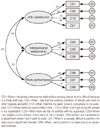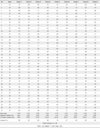Abstract
Methods
Data were collected from questionnaires completed by 678 nurses who worked in 3 university hospitals in South Korea and analyzed using the SPSS 18.0 and AMOS 18 programs. Thirty-seven preliminary items were selected from 161 basic items extracted via a literature review and in depth interviews with 6 hospital nurses. Three steps with factor analysis were undertaken to verify the reliability and validity of the preliminary instruments. Finally, confirmative factor analysis was carried out.
Figures and Tables
References
1. Aiken LH, Clarke SP, Sloane DM, Sochalski J, Silber JH. Hospital nurse staffing and patient mortality, nurse burnout, and job dissatisfaction. JAMA. 2002. 288(16):1987–1993.
2. Becker TE. Foci and bases of commitment: Are they distinctions worth making. Acad Manag J. 1992. 35(1):232–244.
3. Cammann C, Fichman M, Jenkins D, Klesh JR. Seashore SE, editor. The michigan organizational assessment questionnaire. Assessing organizational change: A guide to methods, measures, and practices. 1983. New York, NY: Wiley;71–138.
4. Cho CH, Kim MS. An effect of nurses' job stress and job burnout, job satisfaction and turnover intention: Focusing on large-sized hospital in Daegu Gyeongbuk area. 2010. 11. Paper presented at the Korean Academic Association of Business Administration, Seoul.
5. Choi SH. Eight out of ten workers suffers 'workplace hwa-byung'. MoneyToday. 2008. Retrieved October, 13, 2008. from http://news.mt.co.kr/mtview.php?no=2008101308280673003&type=&VR.
6. Choi YH. A study on stress and job satisfaction among oriental hospital nurses. J Korean Acad Nurs Adm. 1999. 5(1):169–180.
7. Cook JD, Hepworth SJ, Wall TD, Warr PB. The experience of work: A compendium and review of 249 measures and their use. 1981. New York, NY: Academic Press.
8. Cooper CL, Marshall J. Occupational sources of stress: A review of the literature relating to coronary heart disease and mental ill health. J Occup Psychol. 1976. 49(1):11–28. http://dx.doi.org/10.1111/j.2044-8325.1976.tb00325.x.
9. Flinkman M, Laine M, Leino-Kilpi H, Hasselhorn HM, Salanterä S. Explaining young registered finnish nurses' intention to leave the profession: A questionnaire survey. Int J Nurs Stud. 2008. 45(5):727–739. http://dx.doi.org/10.1016/j.ijnurstu.2006.12.006.
10. Hospital Nurses Association. Research on the status of nursing personnel. 2011. Seoul: Author.
11. Jones CB. Calculating and updating nursing turnover costs. Nurs Econ. 1992. 10(1):39–45. 78
12. Kang BS, Kim KS. SPSS 17.0: Statistical analysis of the social sciences. 2009. Seoul: Hannarae Academy.
13. Kim IS. The role of self-efficacy and social support in the relationship between emotional labor and burn out, turn over intention among hospital nurses. J Korean Acad Nurs Adm. 2009. 15(4):515–526.
14. Kim YH, Choi JH, Kim KE. The impact of job overload, relationship with senior on nurses' intention to quit their jobs -Mediating role of emotional exhaust-. J Korean Acad Nurs Adm. 2009. 15(3):372–381.
15. Koo OH. Clinical nurses's perception of empowerment structural model in nursing organization. 2000. Daejon: Chungnam National University;Unpublished doctoral dissertation.
16. Kwon DW, Ko HJ. A study of job stress and turnover intension related to transfer of duty post of staff nurses in the general hospitals. J Korean Acad Nurs Adm. 2003. 9(1):141–150.
17. Lawler EE. Satisfaction and behavior. 1983. New York, NY: McGraw-Hill.
18. Liou SR. Nurses' intention to leave: Critically analyse the theory of reasoned action and organizational commitment model. J Nurs Manag. 2009. 17(1):92–99. http://dx.doi.org/10.1111/j.1365-2834.2008.00873.x.
19. Lynn MR. Determination and quantification of content validity. Nurs Res. 1986. 35(6):382–385.
20. Min S, Kim HS, Ha YJ, Kim EA, Kim HY, Kim HJ, et al. The controlling effect of the self-efficacy in the job stress of hospital nurse on job satisfaction. Korean J Bus Adm. 2011. 24(1):1–21.
21. Ministry of Health & Welfare. Ministry of health and welfare year book 2010. 2010. 12. Retrieved January, 2011. from http://stat.mw.go.kr/front/statData/mohwAnnalsWpView.jsp?menuId=14&bbsSeq=1&nttSeq=16495&nttClsCd=01&searchKey=&searchWord=&nPage=1.
22. Mobley WH. Employee turnover: Causes, consequences, and control. 1982. Reading. MA: Addison-Wesley Publishing Co.
23. Park HS. Relationship between perceived nursing care role orientation, job characteristics, and turnover among nurses. 2002. Seoul: Yonsei University;Unpublished master's thesis.
24. Porter LW, Smith FJ. The etiology of organizational commitment. 1970. Irvine, CA, USA: University of California at Irvine;Unpublished paper.
25. Seashore SE, Lawler EE, Mirvis P, Cammann C. Observing and measuring organizational change: A guide to field practice. 1982. New York, NY: Wiley.
26. Seo YY, Ju HO. Influence of nursing organizational culture on empowerment as perceived by new nurses. J Korean Acad Nurs Adm. 2011. 17(1):88–95.
27. Shader K, Broome ME, Broome CD, West ME, Nash M. Factors influencing satisfaction and anticipated turnover for nurses in an academic medical center. J Nurs Adm. 2001. 31(4):210–216.
28. Sung YH, Hwang MS, Kim KS, Chun NM. Influence of clinical nurse specialists' emotional intelligence on their organizational commitment aand turnover intention. J Korean Acad Nurs Adm. 2010. 16(3):259–266.
29. Tulgan B. Generation X-The workforce of the future. 2000. Retrieved October, 9, 2000. from http://www.rainmakerthinking.com/.
30. Yoon GS, Kim SY. Influences of job stress and burnout on turnover intention of nurses. J Korean Acad Nurs Adm. 2010. 16(4):507–516.




 PDF
PDF ePub
ePub Citation
Citation Print
Print








 XML Download
XML Download